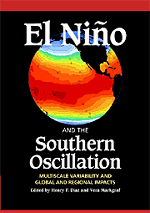Book contents
- Frontmatter
- Contents
- Contributors
- Acknowledgments
- Preface
- SECTION A Global and Regional Characteristics and Impacts of ENSO Variability
- SECTION B Long-Term Changes in ENSO: Historical, Paleoclimatic, and Theoretical Aspects
- 7 The Documented Historical Record of El Niño Events in Peru: An Update of the Quinn Record (Sixteenth through Nineteenth Centuries)
- 8 Tree-Ring Records of Past ENSO Variability and Forcing
- 9 The Tropical Ice Core Record of ENSO
- 10 Long-Term Variability in the El Niño/Southern Oscillation and Associated Teleconnections
- 11 Modulation of ENSO Variability on Decadal and Longer Timescales
- 12 Global Climate Change and El Niño: A Theoretical Framework
- 13 The Past ENSO Record: A Synthesis
- Index
12 - Global Climate Change and El Niño: A Theoretical Framework
from SECTION B - Long-Term Changes in ENSO: Historical, Paleoclimatic, and Theoretical Aspects
Published online by Cambridge University Press: 04 August 2010
- Frontmatter
- Contents
- Contributors
- Acknowledgments
- Preface
- SECTION A Global and Regional Characteristics and Impacts of ENSO Variability
- SECTION B Long-Term Changes in ENSO: Historical, Paleoclimatic, and Theoretical Aspects
- 7 The Documented Historical Record of El Niño Events in Peru: An Update of the Quinn Record (Sixteenth through Nineteenth Centuries)
- 8 Tree-Ring Records of Past ENSO Variability and Forcing
- 9 The Tropical Ice Core Record of ENSO
- 10 Long-Term Variability in the El Niño/Southern Oscillation and Associated Teleconnections
- 11 Modulation of ENSO Variability on Decadal and Longer Timescales
- 12 Global Climate Change and El Niño: A Theoretical Framework
- 13 The Past ENSO Record: A Synthesis
- Index
Summary
Abstract
To better understand what drives El Niño, an analytical model of the coupled oceanatmosphere system over the equatorial Pacific is constructed. The equatorial atmosphere is approximated as a linear feedback system whose surface winds are driven by sea surface temperature (SST) gradients and whose thermal effect is to restore the entire equatorial SST to its maximum value – the SST of the warm pool. The upper ocean is represented by a shallow-water model capped by a mixed layer with a constant depth. The zonal mean stratification of the thermocline is maintained by upwelling from the deep ocean. The model captures the oscillatory behavior of the present tropical Pacific climate – the El Niño Southern Oscillation (ENSO). The main features of the oscillation in the model agree well with the observed El Niño, including the period of the oscillation and the phase relationship between the variations of SST and the variations in the depth of the thermocline. Moreover, the model predicts that the climate of the eastern tropical Pacific has two regimes: One is warm and steady, and the other is cold and oscillating, consistent with the inference from geoarcheological data that El Niño did not exist during the early to mid-Holocene, when the global and regional climates were warmer than today. The transition from the steady climate to the oscillating climate takes place when the temperature contrast between the surface warm pool and the deep ocean exceeds a critical value.
- Type
- Chapter
- Information
- El Niño and the Southern OscillationMultiscale Variability and Global and Regional Impacts, pp. 441 - 462Publisher: Cambridge University PressPrint publication year: 2000



